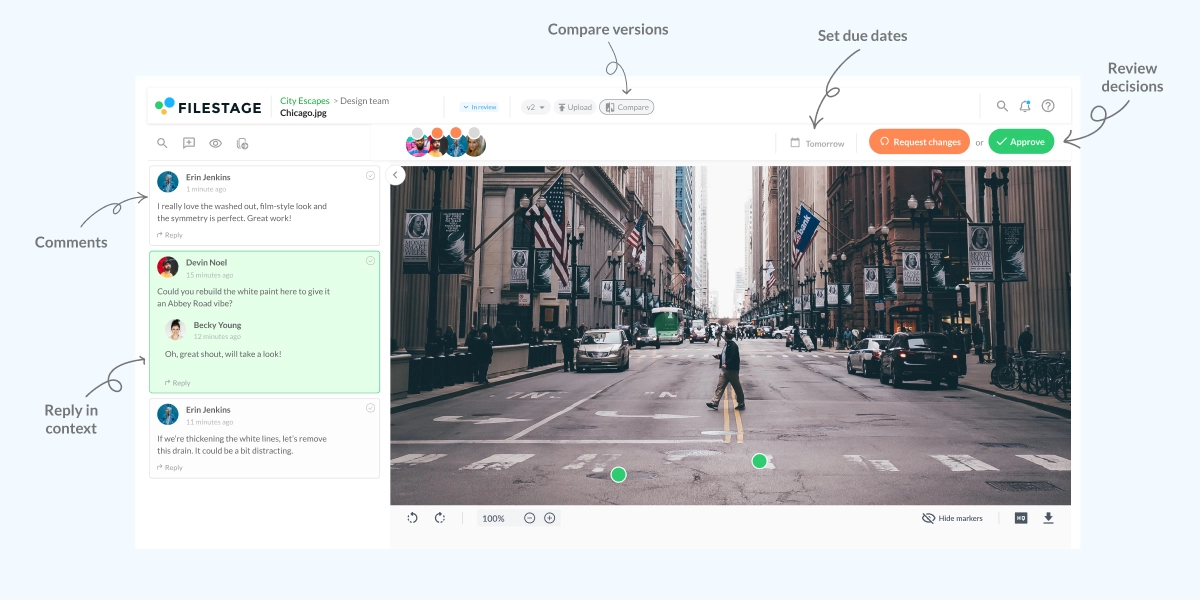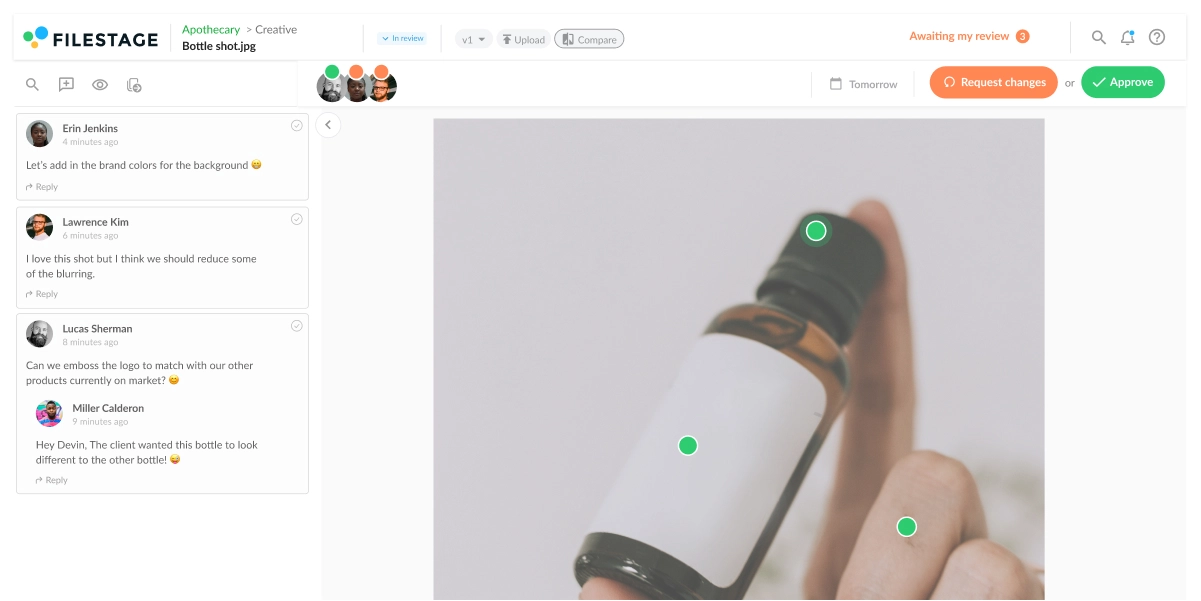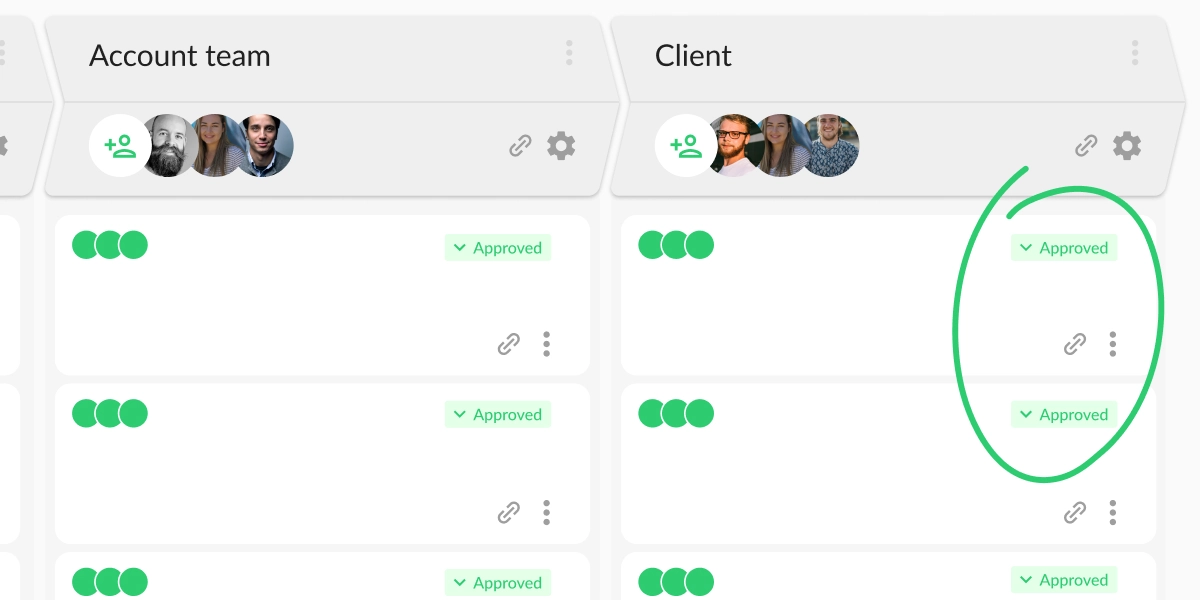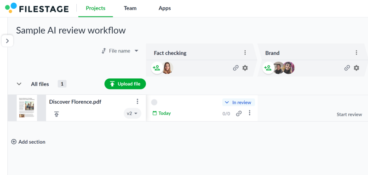Did you know that almost 90% of people say they’d feel happier at work if their team had a more efficient review and approval process?
That’s a hell of a number.
On top of that, effective approval workflows bring companies financial gains, saves time, and improves overall productivity.
So, instead of asking yourself whether you need a more efficient workflow, try asking yourself, “How do I create the most effective approval workflow possible for my team?”
Let’s dive deeper into different types of approval requests, workflows, and ways you can optimize them. Plus, all the ways approval workflow software can help you create the most effective approval workflows.
What is an approval workflow?
An approval workflow is a standard business practice where team members and other stakeholders must approve certain milestones and steps in the production process to make sure that the final content meets all relevant standards.
The approval workflow can range from being straightforward with one or two review steps to becoming highly complex by including various external stakeholders and multiple review rounds.
Depending on the industry and the type of work, there are three types of approval workflows.
Let’s have a look at all three of them!
Three types of approval workflow(and how to build them)
To make the process from production to publishing content as fast and efficient as possible, you need to build effective approval workflows. But different fields and industries require various procedures and practices when creating approval workflows.
So, let’s look at the different types of approval workflows and their characteristics.
1. Social media approval workflows
Working in social media is all about creating a transparent and efficient approval workflow for your clients or internal stakeholders. When posting on social media, it’s essential to have timely information, the right angle, and to know which information to share with your audience.
Here are four steps you need to follow to build an effective social media approval workflow:
- Decide which stakeholders need to be involved
- Set due dates for review rounds
- Fit the approval workflow into your overall social media workflow
- Use a social media approval workflow software
Decide which stakeholders need to be involved
Is your manager or your client the only person that needs to see your post? Or is there someone else, like the Art Director or the CMO, who also needs to approve the content?
Whether you’re working as an in-house social media manager or you’re handling social media for a client, it’s essential to know who needs to be involved in the approval workflow.
Set due dates for review rounds
When working on content that needs others’ approval, it’s important to plan your content creation and approval deadlines realistically. You want to avoid chasing your client or manager for approval just hours before the post goes live.
Instead of using traditional approval systems, set due dates for every review round you’ll have and get your reviewers notified when it’s time for them to provide their feedback or approval.
Fit the approval workflow in your overall social media workflow
The content creation workflow typically consists of setting up topics, creating a content calendar, working on graphics and developing the copy, and getting feedback and approval from your client. And approval usually takes part in the final stage.
Once you map out your overall social media workflow, you should also dedicate time and effort to the approval workflow and have it fit with the original deadlines and goals. This way, you’ll become more efficient in content creation and more confident in the outcome.
Use a social media approval tool
A dedicated social media approval tool will help you create a seamless and effective approval chain with less effort. With a tool like Filestage, you’ll have a centralized feedback platform to receive all feedback and approval in one place.
Plus, you can set deadlines for your reviewers, and they’ll receive automatic reminders to make sure they provide feedback or approval before the due date.
For more details on what approval workflow software look like, and how they can help you optimize your approval process in just a few clicks, you can check out the video.
2. Artwork and packaging approval workflows
The artwork and packaging approval workflow is unique as it takes longer and requires more stakeholders to get the final approval.
In the packaging approval workflows, the emphasis is highly on meeting legal and regulatory requirements, which requires more precision and attention to detail.
Here are four steps that will help you transform your artwork approval process:
- Upload and share your artwork
- Invite reviewers to add comments and discuss feedback
- Make edits and share the next version
- Get approval and send your artwork to print
Upload and share your artwork
Firstly, setting up an efficient artwork and packaging approval workflow engine will be much simpler with a dedicated approval platform.
With Filestage, you’ll have a centralized place for all your projects, files, versions, teammates, stakeholders, and all their feedback – all in one tool.
You can review and approve all the different formats of your artwork in one place, for example:
- Billboard
- Poster
- Print ad
- A5 flyer
- Packaging
Invite reviewers to add comments and discuss feedback
The number of people that need to be involved in the artwork approval workflow can be overwhelming. That is especially true in regulated industries like pharmaceuticals, alcohol, or gambling.
Here are a few ways Filestage makes giving and discussing feedback quick and easy:
- Annotations – draw on the content to add clarity to your comments
- Attachments – share references or important files like fonts and logos
- Highlights – select specific words and sentences that need editing
- Strikeouts – select which parts of a document you want to be deleted
Make edits and share the next version
When handling your approval processes over email, versions, and comments get lost in endless email chains. This makes reviewing new versions a huge headache, as everyone needs to track down their old feedback to see what was wrong last time.
In an approval workflow software like Filestage, you can compare versions to view two versions of your content side by side. This way you can quickly check the previous comments and see what’s new.
Plus, your reviewers can choose to “Approve” a file or “Request changes,” so you’re always clear on the status of your content.
Get approval and send your artwork to print
The final step of your approval workflow process is getting the actual approval from all stakeholders.
With Filestage, you can easily track who has and hasn’t signed off on your artwork. If it’s approved, the status indicator will be green. And once you’ve successfully gathered all the approvals, you’re ready to send the artwork to print with confidence.
Learn in our blog how to building a successful artwork and packaging approval process
3. Video content approval workflows
Video content approval processes are specific because of the amount of approval and review rounds it takes to get a single video polished and ready for publishing.
That’s why you can easily save time and resources for each video project you produce if you manage this workflow efficiently.
Here are the three most important things to consider when developing your video content approval workflow:
- Define all tasks
- Determine important stakeholders
- Map out necessary actions
Define all tasks
First and foremost, it’s essential that you define all the bigger and smaller tasks in video production and approval. Here you determine everything from the project’s scope to the script and the overall video production workflow.
Each of these three major tasks requires separate approval before you can deal with the next one. Only once you get approval from essential stakeholders about the project’s scope can you deal with developing the script and seek approval for it.
Therefore, make sure to map out and group all your tasks before kicking off any video project.
Determine important stakeholders
Defining important stakeholders is the second important step in getting your video approval workflow. And you’ll probably need different stakeholders to approve various tasks in the project.
Try asking yourself: Who needs to approve the scope of the project? Are the same people involved in approving the script? And who do you turn to for approval on the video production workflow?
Once you have the answers, involving all the important stakeholders in your video content approval process becomes much easier.
Map out important actions
Each milestone in video production means handling a list of different actions. Though this is only indirectly tied to the video content approval workflow, it’s still important to correctly assign each action to each team or person.
By being transparent and setting up accountability, you’ll make sure everything stays on schedule and that your approval workflow engine runs smoothly.
Five steps to create an effective approval process
Different fields and types of creative content require specific approaches in approval workflows. But there are certain steps and characteristics that each approval workflow should consist of if you want to end up having all your approvals in one place in time for publishing.
To make your approval workflow effective and save time and nerves, you should switch from handling your approval process over emails to having a dedicated tool.
Here’s how you can create an effective approval process in Filestage:
- Align all your stakeholders
- Share files in a centralized platform
- Gather relevant feedback
- Create and share the next version
- Repeat the process until you get an approval
1. Align all your stakeholders
Setting up a successful approval process is all about involving and aligning stakeholders on the specifics of the project.
With Filestage, you’ll be able to organize your reviewers into review steps and collect everyone’s feedback and approval on top of your work.
Here’s how you can organize automated approval workflows in Filestage to align all your stakeholders:
- Creative – for discussing creative ideas, execution, and style
- Marketing – for reviewing whether the content meets brand guidelines
- Legal and compliance – for checking if the work is in line with relevant regulations

2. Share files in a centralized platform
Just think of when you received some feedback in your Slack channel, other teammates gave it over email, and your client called you to elaborate on their feedback. Plus, their feedback was completely contradictory for some parts of your work.
To avoid getting exhausted and confused from conflicting feedback handled in different places, you need a centralized platform like Filestage, where you’ll share all your work and gather everyone’s feedback.
With Filestage, you can:
- Upload as many versions of your files as you need to reach approval
- Create different review steps for various stakeholders and avoid conflict
- Have your reviewers “Request changes” or “Approve” your work, so you always know if you still need to improve your project
- Create automated approval workflows for faster approval
3. Gather relevant feedback
In most cases, you’re looking for approval from at least three stakeholders. You’re probably managing approvals from your manager, your art or marketing director, and your client approving most of your work.
And for a successful approval process, you need to make gathering all their feedback as effortless as possible.
Here are a few ways Filestage makes feedback easier:
- Zoom, rotate, and drag to hone in on every detail of your designs
- Click anywhere to create a marker and add a comment
- Highlight text to give feedback on a specific word or sentence
- Strikeout text to show which parts should be deleted
- Draw annotations to make feedback clearer and more visual
- Add references and essential assets as attachments to comments

4. Create and share the next version
One of the biggest advantages of approval software is reliable version control.
Tools like Google Docs are very appealing for fast collaboration. But, once everyone with access to the document starts making changes, there’s no way to go back and track progress across previous versions.
In an approval software like Filestage, you can share as many versions of your files as needed and have them neatly organized in your dashboard. This makes tracking feedback and the progress of your project super easy.
Here’s how Filestage version control improves your overall workflow approval:
- Have an overview of constantly evolving files and every edit or resolved comment
- Know exactly where to draw the line between one version and the next
- Avoid having reviewers duplicate your file and make edits directly
- Make sure people don’t waste time giving feedback on the wrong version
- Track files through different approval steps and make sure to always know the accurate approval status

5. Repeat the process until you get approval
Finally, once all your files are carefully reviewed and polished, it’s time to gather final approvals from everyone involved with the project. To make sure your work gets all the green lights it needs before publishing, you need your stakeholders’ explicit approval.
In Filestage, your reviewers can choose between two buttons every time they give feedback:
- ✓ Approve
- ↻ Request changes
This instantly changes their status indicator to green or orange in your project dashboard, depending on their choice. So you can easily see what needs more work and what can move on to the next document review step.

Why your team needs a great workflow approval process
Setting up an efficient approval process for you and your team will help streamline your processes and have all projects done faster with fewer mistakes made along the way.
There’s no doubt that getting feedback on top of your work is good for the quality of the final project. But, you can either stick to clunky manual processes that will frustrate and demotivate everyone involved, or you can try your best to optimize them.
Once all team members experience efficient approval workflows, they will start producing better work and enjoy giving and receiving feedback more.
Final thoughts
Effective approval workflows saves everyone’s time, improves productivity, and helps companies improve financial gains. And depending on the industry you’re in, the type of your approval workflow can slightly differ.
But at the end of the day, all successful approval workflows involve great organization and require using specialized tools.
Check out why Filestage should be your go-to tool for approval workflows and start a free trial.










